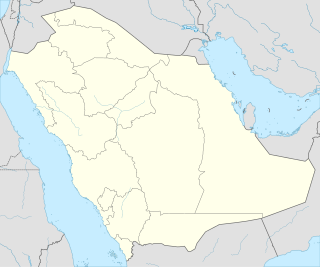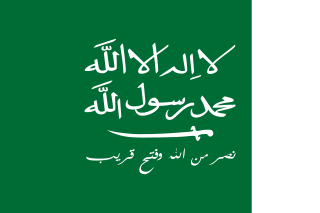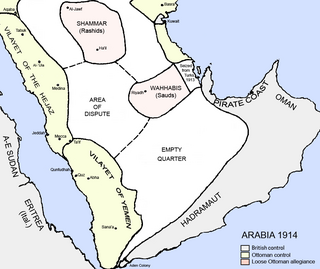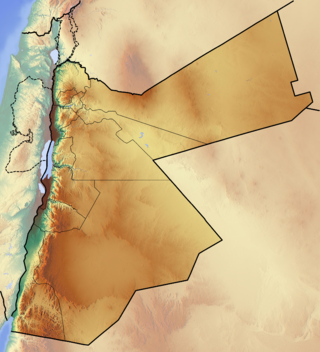
The history of Saudi Arabia as a nation state began with the emergence of the Al Saud dynasty in central Arabia in 1727 and the subsequent establishment of the Emirate of Diriyah. Pre-Islamic Arabia, the territory that constitutes modern Saudi Arabia, was the site of several ancient cultures and civilizations; the prehistory of Saudi Arabia shows some of the earliest traces of human activity in the world.

The Hejaz is a region that includes the majority of the west of Saudi Arabia, covering the cities of Mecca, Medina, Jeddah, Tabuk, Yanbu, Taif and Baljurashi. It is thus known as the "Western Province", and it is bordered in the west by the Red Sea, in the north by Jordan, in the east by the Najd, and in the south by the Region of 'Asir. It is the most cosmopolitan region in the Arabian Peninsula. Its largest city is Jeddah, which is the second-largest city in Saudi Arabia, with Mecca and Medina, respectively, being the fourth- and fifth-largest cities in the country.

The flag of Saudi Arabia is entirely green except for the central portion which bears an Arabic inscription and a sword in white. The inscription is the Islamic creed, or shahada: "There is no deity but God; Muhammad is the Messenger of God". The current design has been used by the government of Saudi Arabia since 15 March 1973.

The Provinces of Saudi Arabia, also known as Regions, and officially the Emirates of the Provinces of the Kingdom of Saudi Arabia, are the 13 first-level administrative divisions of the Kingdom of Saudi Arabia.

The Emirate of Diriyah, also known as the First Saudi State, was established in February 1727. In 1744, the emir of a Najdi town called Diriyah, Muhammad bin Saud, and the religious leader Muhammad ibn Abd al-Wahhab formed an alliance to found a socio-religious reform movement to unify the many states of the Arabian Peninsula.

The Sultanate of Nejd was the third iteration of the Third Saudi State, from 1921 to 1926. It was a monarchy led by the House of Saud, and a legal predecessor of modern-day Saudi Arabia. This version of the Third Saudi State was created when Abdul Aziz ibn Saud, Emir of Riyadh, declared himself sultan over Nejd and its dependencies. On the 2 December 1922, the Nejd signed an agreement with Kuwait defining their border with each other. The border would be a straight line along the 29th parallel. In December 1925, the Kingdom of Hejaz surrendered to the forces of Abdul Aziz ibn Saud, who was thereafter proclaimed king of Hejaz in January 1926 and merged his dominions into the Kingdom of Hejaz and Nejd.

The Unification of Saudi Arabia was a military and political campaign in which the various tribes, sheikhdoms, city-states, emirates, and kingdoms of most of the central Arabian Peninsula were conquered by the House of Saud, or Al Saud. Unification started in 1902 and continued until 1932, when the Kingdom of Saudi Arabia was proclaimed under the leadership of Abdulaziz, known in the West as Ibn Saud, creating what is sometimes referred to as the Third Saudi State, to differentiate it from the Emirate of Diriyah, the First Saudi State and the Emirate of Nejd, the Second Saudi State, also House of Saud states.

The Kingdom of Hejaz and Nejd, initially the Kingdom of Hejaz and Sultanate of Nejd, was a dual monarchy ruled by Abdulaziz following the victory of the Saudi Sultanate of Nejd over the Hashemite Kingdom of the Hejaz in 1925. It was the fourth iteration of the Third Saudi State.

The Third Saudi state is the heir to the two earlier Saudi states: the first and the second, founded by Abdul Aziz bin Abdul Rahman, who managed to capture the city of Riyadh on January 13, 1902. A long series of conflicts and conquests ultimately led to the establishment of the modern and contemporary Saudi state, the Kingdom of Saudi Arabia.

The Emirate of Riyadh was the first iteration of the Third Saudi State from 1902 to 1913. It was a monarchy led by the House of Saud. The state was formed after Saudi forces seized Riyadh from the control of the Emirate of Ha'il, led by the House of Rashid, during the Battle of Riyadh. It was the direct antecedent of the Emirate of Nejd and Hasa, and the earliest legal predecessor of present-day Saudi Arabia. Al-Hasa was conquered in 1913.
The Saudi conquest of Hejaz or the Second Saudi-Hashemite War, also known as the Hejaz-Nejd War, was a campaign engaged by Saudi Sultan Abdulaziz to take over the Hashemite Kingdom of Hejaz in 1924–25, ending with conquest and incorporation of Hejaz into the Saudi domain.
The Taif massacre was an incident that followed the short 1924 Battle of Taif; the entire episode is also known as the al-Taif incident. The battle and resultant massacre comprised the first major standoff of the Second Hashemite-Saudi War. Following a short siege, the city was abandoned by Hashemite forces and then capitulated to the battle-ready Ikhwan force under the command of Abdulaziz Ibn Saud. The Ikhwan troops took out their rage on the residents of the city. In the resulting bloodbath, some 300-400 Ta'if residents were massacred.
The First Saudi–Hashemite War, also known as the First Nejd–Hejaz War or the al-Khurma dispute, took place in 1918–19 between Abdulaziz Ibn Saud of the Emirate of Nejd and Hasa and the Hashemites of the Kingdom of Hejaz.

Saudi National Day is a public holiday in Saudi Arabia celebrated annually on 23 September to commemorate the proclamation that renamed the Kingdom of Nejd and Hejaz as the Kingdom of Saudi Arabia in 1932 through a royal decree by King Abdulaziz ibn Saud. It was founded in 1965 on its 33rd anniversary by King Faisal bin Abdulaziz in order to replace the Royal Seating Day and was made a public holiday by King Abdullah bin Abdulaziz in 2005. Saudi National Day is one of the three non-religious holidays observed in the country, other being the Saudi Founding Day and Saudi Flag Day.

The king of Saudi Arabia, officially the king of the Kingdom of Saudi Arabia, is the monarch and head of state/head of government of the Kingdom of Saudi Arabia who holds absolute power. He is the head of the Saudi Arabian royal family, the House of Saud. The king is the supreme commander-in-chief of the Royal Saudi Armed Forces and the head of the Saudi national honors system. The king is called the "Custodian of the Two Holy Mosques", a title that signifies Saudi Arabia's jurisdiction over the mosques of Masjid al-Haram in Mecca and Al-Masjid an-Nabawi in Medina. The title has been used many times through the history of Islam. The first Saudi king to use the title was Faisal; however, King Khalid did not use the title after him. In 1986, King Fahd replaced "His Majesty" with the title of Custodian of the Two Holy Mosques, and it has been since used by both King Abdullah and King Salman. The king has been named the most powerful and influential Muslim and Arab leader in the world according to the Muslim 500.

The Ottoman era in the history of Arabia lasted from 1517 to 1918. The Ottoman degree of control over these lands varied over these four centuries, with the fluctuating strength or weakness of the Empire's central authority.

The Jordan–Saudi Arabia border is 731 km (454 mi) in length and runs from the Gulf of Aqaba in the south-west to the tripoint with Iraq in the north-east.

Bani Khalid Emirate or the Emirate of Al Humaid from the Bani Khalid tribe was a state that arose in the eastern region of the Arabian Peninsula in year 1669 after Emir Barak bin Ghurair made his capital in Al-Mubarraz then managed to defeat the Ottoman Empire represented by Lahsa Eyalet and drove them out of the region. The Emirate of Al Hamid ended in the year 1796 after the defeat of Barak bin Abdul Mohsen at the hands of the First Saudi State.

The Declaration of theUnification of Saudi Arabia was officially announced by Prince Faisal bin Abdulaziz, the Viceroy of Hejaz on behalf of King Abdulaziz ibn Saud on September 23, 1932, at 9:00 am from al-Hamidiyah Palace in Mecca. Faisal read out the Royal Decree No. 2716 issued by Abdulaziz ibn Saud on September 18, 1932, that renamed the Kingdom of Hejaz and Nejd and its annexes as the Kingdom of Saudi Arabia.















